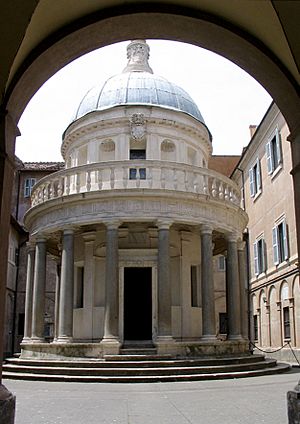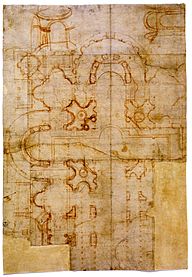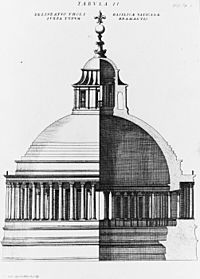Donato Bramante facts for kids
Quick facts for kids
Donato Bramante
|
|
|---|---|

Donato Bramante
|
|
| Born |
Donato di Pascuccio d'Antonio
1444 Fermignano, Duchy of Urbino (present-day Italy)
|
| Died | 11 April 1514 (aged 69–70) |
| Nationality | Italian |
| Known for | Architecture, painting |
|
Notable work
|
San Pietro in Montorio |
| Movement | High Renaissance |
Donato Bramante (1444 – 11 April 1514) was a famous Italian architect and painter. His full name was Donato di Pascuccio d'Antonio. He was also known as Bramante Lazzari.
Bramante brought the new Renaissance architecture style to Milan. He also introduced the High Renaissance style to Rome. His design for St. Peter's Basilica in Rome was very important. It became the main idea for Michelangelo to finish the building.
One of his most famous works is the Tempietto. This small building in Rome marked the start of the High Renaissance there in 1502. Pope Julius II asked Bramante to build it. It stands on the spot where Saint Peter was believed to have died.
Contents
Life of Bramante
Early Life in Urbino
Donato Bramante was born in 1444. His birthplace was Fermignano, a town near Urbino in Italy. Urbino was a center for art and learning during the Renaissance.
As a young man, Bramante learned about art and design. He knew famous painters like Melozzo da Forlì and Piero della Francesca. These artists were very interested in perspective. This is a way of drawing to make things look three-dimensional. Bramante also learned from the illusionistic art of Andrea Mantegna.
Working in Milan
Around 1474, Bramante moved to Milan. This city had many old Gothic buildings. Bramante began to build churches in a new style. This style was inspired by ancient Roman buildings.
The Duke of Milan, Ludovico Sforza, hired Bramante. He became the Duke's main architect. One of his most famous works in Milan is the choir of the church of Santa Maria presso San Satiro. He built this between 1482 and 1486.
Space was tight for this church. So, Bramante created a clever trick called a trompe-l'œil (which means "deceive the eye"). He made a flat wall look like a deep, curved space. He used perspective to create this amazing illusion. He also built an octagonal room with a dome.
Bramante also worked on the tribune of Santa Maria delle Grazie. This was built from 1492 to 1499. Other early works include the Cloisters of Sant'Ambrogio. He also helped design the Pavia Cathedral.
In 1499, the French army invaded Milan. Duke Sforza had to leave. Bramante then moved to Rome. He was already known to powerful people there.
Great Works in Rome
In Rome, Bramante quickly gained recognition. He was noticed by Pope Julius II. The Pope soon hired Bramante for major projects.
One of his first big designs in Rome was the Tempietto. He built this small temple in 1502. It was for Ferdinand of Aragon and Isabella of Castile, or possibly Pope Julius II. The Tempietto is a perfect example of Renaissance design. It has balanced shapes and symmetry. It is surrounded by slender Doric columns and topped with a dome.
In 1503, Pope Julius II gave Bramante his biggest job. This was to completely rebuild St. Peter's Basilica. This would be the grandest building project in Europe. The first stone for the new St. Peter's was laid on April 17, 1506.
Bramante imagined St. Peter's Basilica as a Greek cross shape. This shape was seen as perfect at the time. His plan included a huge central dome. He also planned four smaller domes around it. This design was very much like ancient Roman and Byzantine buildings. However, the church was changed after Bramante's death in 1514. The nave (the long part of the church) was made longer.
Bramante also worked on other projects in Rome. One of his early works there was the cloister of Santa Maria della Pace. This was built between 1500 and 1504. It is near Piazza Navona.
Main Works
Here are some of Bramante's important works:
- Santa Maria presso San Satiro, Milan, around 1482–1486
- Santa Maria delle Grazie (cloister and apse); Milan, 1492–1498
- The Tempietto, San Pietro in Montorio, Rome, 1502
- Santa Maria della Pace (cloister); Rome, 1504
- St. Peter's Basilica, Rome, design 1503, started 1506
- Cortile del Belvedere, Vatican City, Rome, 1506
- Palazzo Caprini (also known as Raphael's House), Rome, started around 1510 (this building was taken down later)
Besides building, Bramante also wrote about architecture. He even wrote eighty sonnets, which are a type of poem.
See also





